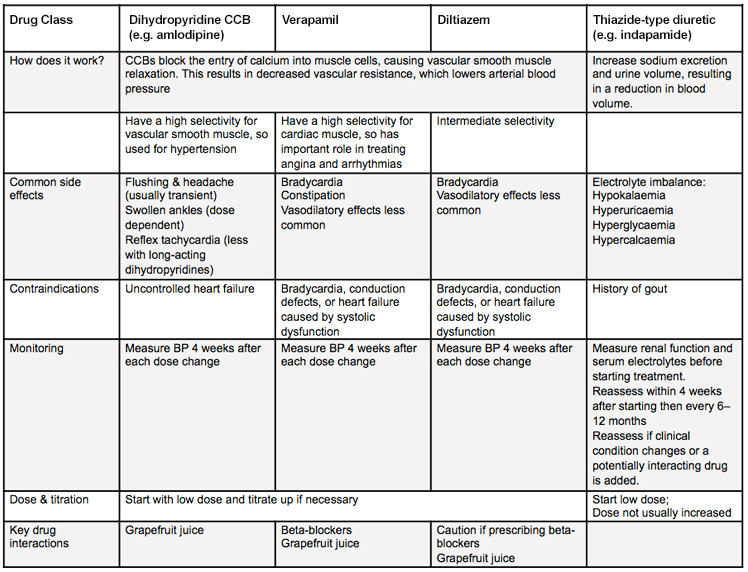First choice of antihypertensive for Evelyn is a calcium channel blocker (CCB) although a thiazide diuretic could be used at this stage if she was intolerant of the CCB, she had oedema, or was at risk of heart failure.
But which CCB should she be prescribed?
The decision to use either a rate-limiting or a dihydropyridine calcium-channel blocker will depend on the person’s co-morbidities and other drugs the person is taking.

NEXT STEP: Evelyn is prescribed amlodipine 5mg, once a day, and advised to come back in 4 weeks to see how she is getting on
Dihydropyridine CCB (e.g. amlodipine)
How does it work?
CCBs block the entry of calcium into muscle cells, causing vascular smooth muscle relaxation. This results in decreased vascular resistance, which lowers arterial blood pressure.
Common side effects
flushing and headache (usually transient)
Swollen ankles (dose-dependent)
Reflex tachycardia (less with long-acting dihydropyridines)
Contraindications
Uncontrolled heart failure
Monitoring
Measure BP 4 weeks after each dose change
Dose and titration
Start with low dose and titrate up if necessary
Key drug interactions
grapefruit juice
Verapamil
How does it work?
CCBs block the entry of calcium into muscle cells, causing vascular smooth muscle relaxation. This results in decreased vascular resistance, which lowers arterial blood pressure.
Have a high selectivity for cardiac muscle, so has an important role in treating angina and arrhythmias
Common side effects
Bradycardia
Constipation
Vasodilatory effects less common
Contraindications
Bradycardia, conduction defects, or heart failure caused by systolic dysfunction
Monitoring
Measure BP 4 weeks after each dose change
Dose and titration
Start with low dose and titrate up if necessary
Key drug interactions
grapefruit juice
beta-blockers
Diltiazem
How does it work?
CCBs block the entry of calcium into muscle cells, causing vascular smooth muscle relaxation. This results in decreased vascular resistance, which lowers arterial blood pressure.
intermediate selectivity
Common side effects
Bradycardia
Vasodilatory effects less common
Contraindications
Bradycardia, conduction defects, or heart failure caused by systolic dysfunction
Monitoring
Measure BP 4 weeks after each dose change
Dose and titration
Start with low dose and titrate up if necessary
Key drug interactions
grapefruit juice
Caution if prescribing beta-blockers
Thiazide-type diuretic (e.g. indapamide)
How does it work?
Increase sodium excretion and urine volume, resulting in a reduction of blood volume
intermediate selectivity
Common side effects
Electrolyte imbalance: Hypokalaemia
Hyperuricaemia
Hyperglycaemia
Hypercalcaemia
Contraindications
History of gout
Monitoring
Measure renal function and serum electrolytes before starting treatment.
Reassess within 4 weeks after starting then every 6-12 months
Reassess if clinical condition changes or a potentially interacting drug is added.
Dose and titration
Start low dose; dose not usually increased
Key drug interactions
N/A
Pulse point
Choice of thiazide-type diuretic
Check your local recommendations for which thiazide-type diuretic should be prescribed for hypertension. Bendroflumethiazide has, historically, been the most widely used thiazide-type diuretic in the UK. However, there is a lack of trial data on the efficacy of low-dose bendroflumethiazide (typically 2.5 mg) compared with other thiazide-type diuretics, such as chlortalidone and indapamide. The NICE guideline concluded that although it could not confirm that low-dose bendroflumethiazide is ineffective, there is less evidence for its effect on clinical outcomes compared with indapamide and chlortalidone. If a thiazide-type diuretic is to be started, NICE, therefore, recommends indapamide and chlortalidone, in preference to bendroflumethiazide. However, if a person is already taking bendroflumethiazide 2.5 mg and their blood pressure is well controlled, there is no compelling reason to change this.
Page last reviewed: 17 Sep 2020


